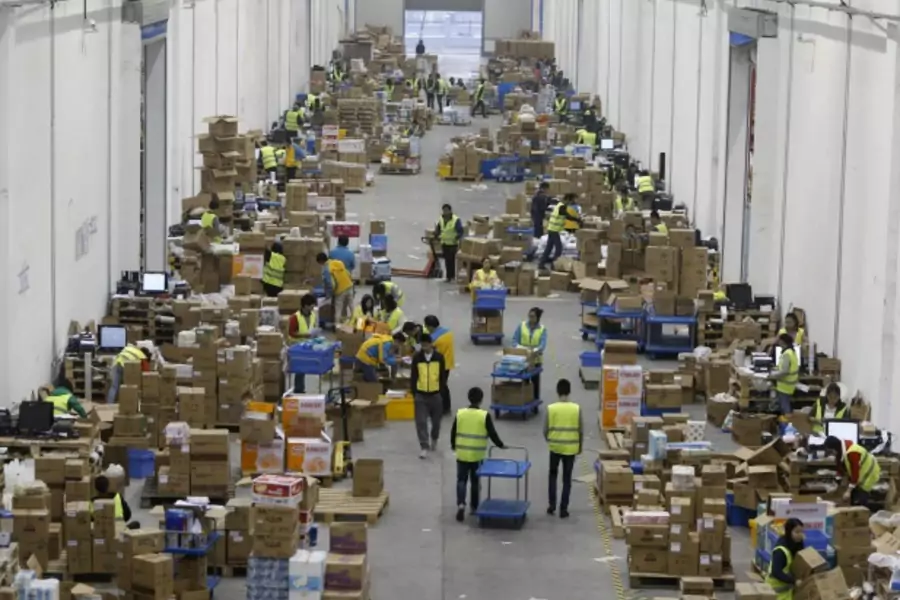Amid Slowing Trade, What’s Next for Global Supply Chains?

More on:
Global trade and the supply chains that support it are undergoing a period of profound change. Supply chains face threats including a resurgence of protectionism, climate change, decaying infrastructure, and human rights abuses. The Development Channel’s series on global supply chains will highlight experts’ analysis on emerging trends and challenges. This post is from Wolfgang Lehmacher, head of supply chains and transport industry at the World Economic Forum (WEF) USA.
Global trade volumes have plateaued over the past eighteen months, after decades of expanding twice as fast as gross domestic production (GDP) and driving economic growth. Supply chains were crucial to that trade expansion, as countries increasingly linked into the procurement, manufacturing, and distribution networks that constitute the chains.
Amid current stagnation, the question is where trade goes next. Public opinion on trade will matter, as will several major shifts in global supply chains.
Diverging Public Support for Trade
Europe is turning inward, despite the fact that 90 percent of global demand will come from outside the European Union (EU) in the next decade. In voting to leave the EU, British citizens rejected one of the strongest multi-nation, regional economic blocs. And European countries’ fragmented response to the migrant crisis bodes badly for EU plans for deeper integration and coordinated borders. In the United States, both Hillary Clinton and Donald Trump have taken strong stands against the Trans-Pacific Partnership (TPP), a preferential free trade agreement binding twelve nations and 40 percent of global GDP.
In contrast, Asian nations are embracing international trade. For them, the TPP is largely understood as an opportunity. China—not a TPP member—is working to create its own bloc, the Regional Comprehensive Economic Partnership (RCEP) as an alternative to the U.S.-led pact. RCEP, composed of sixteen countries, would be the world’s largest free-trade area, reducing barriers to trade in goods and services as well as investment. Meanwhile, the ASEAN Economic Community (AEC) is guiding the region towards a single market, envisioning the free flows of goods, services, labor, investments, and capital across the ten member states. And bilateral agreements proliferate—for example, earlier this year, Vietnam finalized a free trade agreement with the EU.
On the multinational front, World Trade Organization (WTO) members are in the process of ratifying the Trade Facilitation Agreement (FTA) concluded at the 2013 Bali Ministerial Conference. The TFA should make international trade easier, quicker, and less costly by removing red tape at borders, such as measures on the release and clearance of goods, and by enhancing cooperation between border agencies. According to WTO estimates, the TFA could cut worldwide trade costs by between 12.5 percent and 17.5 percent and create around 20 million jobs—the majority in developing countries.
Trends in Global Supply Chains
Amid this ongoing debate, the very nature of trade is changing owing to three distinct shifts in global supply chains: the “fast economy” is on the rise, new technologies are proliferating, and e-commerce is expanding.
Many sectors now prioritize speed to meet customer demand. Brands have adapted to a market for faster products—for example, Zara can design, manufacture, and get clothes to its stores in just two weeks. This model allows brands to avoid high inventory and costly bets, instead only producing more of what sells best. Since fast products require shorter and more regional supply chains, they involve less intercontinental trade.
Technology is making supply chains more dynamic. Information technology, the internet of things, big data, and the cloud enable new management processes that allow for longer and more complex supply chains. The Flex Pulse Centre is one example—it streams data on everything from inventories to quality checks to transportation and delivery statuses, allowing central and local teams to remain updated and prepared to address potential disruptions and risks. This global visibility helps companies to decentralize production and open up new factories and distribution centers across the world, which results in a mix of short, medium, and long distance shipments. Other technological innovations localize and shorten supply chains. 3D printing can move production from factories to shops and homes, and some companies are re-shoring and nearshoring to relocate manufacturing to where technology is most advanced and productivity highest. Both trends reduce cross border trade.
Finally, e-commerce and the rise of digital supply chains may boost international trade. Amazon, eBay, and Alibaba, among other e-commerce platforms, enable companies and consumers to buy things globally. They connect millions of manufacturers and billions of consumers, giving even the smallest seller and most distant buyer access to the global market. These connections require logistics and transportation networks that can support the growing number of cross-border transactions as well as regulation suitable to enable transnational e-commerce without jeopardizing sales.
The English economist David Ricardo argued that combining international free trade with industry specialization around a country’s comparative strengths would produce widespread benefits. For this, trade’s slowdown is problematic. While in part due to converging capabilities—developing countries catching up with mature economies in terms of education, skills, infrastructure and logistics—the slowdown is more likely a result of digitization and suspicions among Western publics. But we might be unnecessarily worried: between 1980 and 1985 trade growth slowed dramatically, only to revive. Today, global production processes are evolving rapidly, and there is still room for deepening supply chains and trade links. The current slowdown represents more a shift than a permanent change.
More on:
 Online Store
Online Store